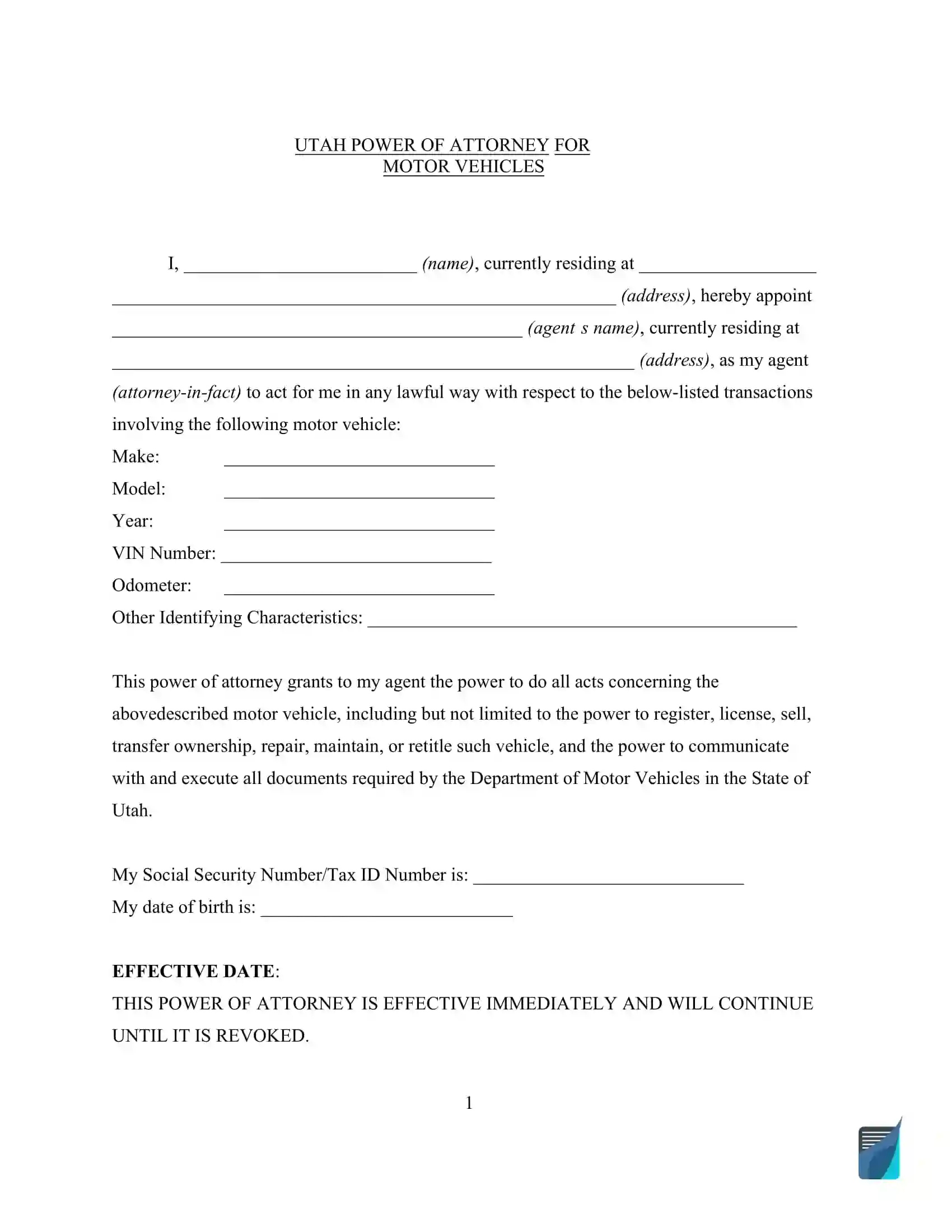Utah Motor Vehicle Power of Attorney Form
The Utah motor vehicle power of attorney is a form that allows you to designate another person to handle specific matters related to your car (registering, buying, or selling the vehicle on your behalf). This form is particularly useful if you cannot be present yourself to handle these transactions.

Build Your Document
Answer a few simple questions to make your document in minutes
Save and Print
Save progress and finish on any device, download and print anytime
Sign and Use
Your valid, lawyer-approved document is ready
Here are the elements you typically need to include in the Utah vehicle power of attorney:
- Your full name and address as the vehicle owner giving the power.
- Full name and address of the person you are appointing as your agent.
- Specific information about the vehicle, such as make, model, year, and VIN.
- Detailed list of the powers you are granting to your agent. This list can include applying for a title, registering the vehicle, or selling it.
Under Utah Code Section 75-9-105, a power of attorney must be signed by the principal or by another person directed by the principal in their presence. This signature must occur in front of a notary public or an authorized official capable of taking acknowledgments.
For those seeking to create a comprehensive legal document, various power of attorney templates are available on our site. Additionally, you can use Utah POA forms to ensure compliance with state-specific regulations.
Utah Motor Vehicle Power of Attorney Form Details
| Document Name | Utah Motor Vehicle Power of Attorney Form |
| State Form Name | None |
| Relevant Link | Utah Division of Motor Vehicles |
| Avg. Time to Fill Out | 15 minutes |
| # of Fillable Fields | 25 |
| Available Formats | Adobe PDF |
Filling Out Utah Vehicle POA
Filling out the Utah motor vehicle power of attorney form is simple. Follow these steps to authorize someone to manage your motor vehicle affairs legally.
1. Principal’s Information
Fill in your full name where indicated and provide your current residential address in the corresponding field.
2. Appointing Your Agent
Enter the full name of the person you appoint as your agent in the space provided. Follow this by entering their full address. This individual will be able to act on your behalf regarding your motor vehicle.
3. Vehicle Details
Specify the vehicle’s make, model, year, VIN (Vehicle Identification Number), odometer reading, and any other identifying characteristics in the respective fields to ensure there is no ambiguity about which vehicle the power pertains to.
4. Powers Granted
This section is generally pre-filled in the form. It outlines the scope of powers you grant to your agent, including registering, licensing, selling, transferring ownership, and other actions necessary for the vehicle’s management.
5. Principal’s Identification and Effective Date
Provide your Social Security Number or Tax ID Number and your date of birth. These details are crucial for the validation of your identity. Also, review the effective date and understand that unless otherwise stated, the POA is immediately active upon signing.
6. Successor Attorney-in-Fact
If you wish to appoint a successor agent who will take over if your primary agent cannot perform, fill in their name and address in the designated areas.
7. Signing and Acknowledgment
Sign and print your name in the designated areas at the end of the document on the indicated day, month, and year. This part must be completed in the presence of a notary public or another officer authorized to take acknowledgments.
8. Notarization
The final page of the form is for the notary public. After you sign the document, the notary will fill out this section, verifying your identity and the signature’s authenticity. They will sign and affix their official seal, making the document legally binding.
